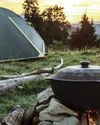
These days, it seems like you can't turn on the TV or click through YouTube without seeing a documentary or spotlight on someone who has shrugged off the shackles of modern capitalism and the humdrum of corporate life to build a tiny house and live a more spartan and frugal lifestyle.
These folks are usually young, idealistic, underemployed as Instagram influencers, and very enthusiastic about their minimalistic endeavor. It's the new craze to combat exorbitant house prices, energy-reliant dwellings, and environmentally unfriendly building practices while rejecting the spacious living epitomes of the affluent. Though the tiny-house movement is nothing new, it has gained a great deal of traction in the last 10 years or so, driving more people to live a simpler life with a less materialistic mindset.
TINY HOUSE HISTORY
Although tiny houses were a mainstay for pioneers, fur trappers, and early settlers in the American frontier, they weren't called "tiny houses;" they were just simple cabins built with the available materials with a zero budget. It wasn't until 1854, when Henry David Thoreau spent two years, two months, and two days in a 150-square-foot home near Waldon Pond that people were first subjected to the merits of modest living, writing in his journal on July 22, 1857, "The rule is to carry as little as possible."
Diese Geschichte stammt aus der June 2022-Ausgabe von American Outdoor Guide.
Starten Sie Ihre 7-tägige kostenlose Testversion von Magzter GOLD, um auf Tausende kuratierte Premium-Storys sowie über 8.000 Zeitschriften und Zeitungen zuzugreifen.
Bereits Abonnent ? Anmelden
Diese Geschichte stammt aus der June 2022-Ausgabe von American Outdoor Guide.
Starten Sie Ihre 7-tägige kostenlose Testversion von Magzter GOLD, um auf Tausende kuratierte Premium-Storys sowie über 8.000 Zeitschriften und Zeitungen zuzugreifen.
Bereits Abonnent? Anmelden

IT'S IN THE BAG
3 WAYS TO HANG A BEAR BAG

HOME DEFENSE
YOU DON'T NEED FANCY GEAR. RELY ON BASIC GUNS AND PROVEN DEFENSIVE MEASURES

GOT GAME?
5 REASONS YOU SHOULD ADD HUNTING TO YOUR SELF-RELIANCE PLAN

CONDOR IMPOSSIBLE MACHETE
THIS NOT-SOIMPOSSIBLE MAGHETE DELIVERS

CAN WE FIX IT? YES WE CAN
PUTTING TOGETHER AN EDC TOOL KIT THAT ACTUALLY WORKS

ON YOUR BEST BEHAVIOR
HOW TO AVOID CONFLICTS WITH LOCALS WHEN TRAVELING ABROAD

SPLURGE TOR SAVE?
A GUIDE TO WHICH CAMPING GEAR DESERVES YOUR HARD-EARNED CASH, AND WHICH GEAR TO SKIMP ON

HOLIDAY WISH LIST
LOOKING FOR GIFT IDEAS? WE HAVE YOU COVERED!

You Can Take It With You
Construct a support/ resupply kit that will keep you sharp and ready

City Survival
Nyerges "Urban survival guide" advocates living simply to be resilient against adversity